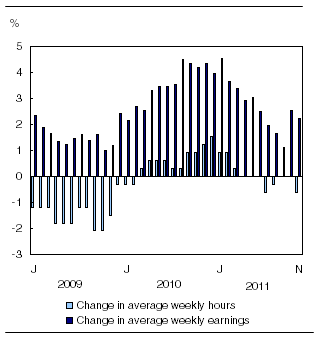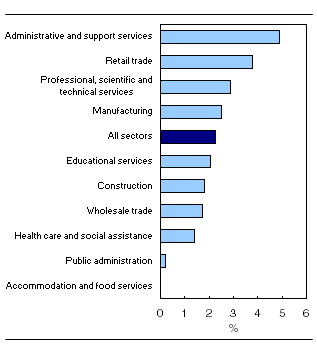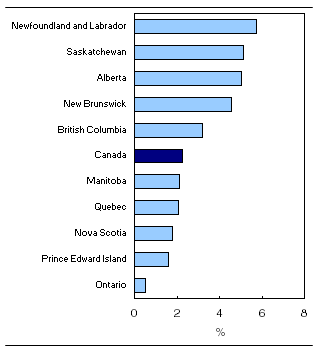Payroll employment, earnings and hours
Archived Content
Information identified as archived is provided for reference, research or recordkeeping purposes. It is not subject to the Government of Canada Web Standards and has not been altered or updated since it was archived. Please "contact us" to request a format other than those available.
Related subjects
-
[an error occurred while processing this directive]
In November, average weekly earnings of non-farm payroll employees were $883.96, virtually unchanged from the previous month. On a year-over-year basis, earnings rose 2.2%.
Year-to-year change in average weekly hours and average weekly earnings

Chart description: Year-to-year change in average weekly hours and average weekly earnings
The 2.2% increase in average weekly earnings during the 12 months to November reflects a number of factors, such as wage growth and changes in the composition of employment by industry, occupation and level of job experience.
Note to readers
The Survey of Employment, Payrolls and Hours (SEPH) is a business census of non-farm payroll employees. Its key objective is to provide a monthly portrait of the level of earnings, the number of jobs and hours worked by detailed industry at the national, provincial and territorial level.
Statistics Canada also produces employment estimates from its monthly Labour Force Survey (LFS). The LFS is a household survey whose main objective is to divide the working-age population into three mutually exclusive groups: the employed (including the self-employed), unemployed and not in the labour force. This survey is the official source for the unemployment rate and collects data on the socio-demographic characteristics of all those in the labour market.
As a result of conceptual and methodological differences, estimates of changes from SEPH and LFS do differ from time to time. However, the trends in the data are quite similar.
Unless otherwise stated, this release presents seasonally adjusted data, which facilitates comparisons by removing the effects of seasonal variations.
Non-farm payroll employment data are for all hourly and salaried employees, as well as the "other employees" category, which includes piece-rate and commission-only employees.
Average weekly hours data are for hourly and salaried employees only and exclude businesses that could not be classified to a North American Industry Classification System code.
All earnings data include overtime pay and exclude businesses that could not be classified to a North American Industry Classification System code.
Average weekly earnings are derived by dividing total weekly earnings by the number of employees.
Average hours worked per week can also contribute to changes in earnings. A year-over-year decline in average hours worked per week tempered the increase in weekly earnings. In November, average hours worked per week amounted to 32.9, down from 33.1 hours 12 months earlier. Compared with the previous month, average weekly hours were down slightly (-0.3%).
Average weekly earnings by sector
Year-over-year growth in average weekly earnings exceeded the national average of 2.2% in four of Canada's largest industrial sectors: administrative and support services; retail trade; professional, scientific and technical services; and manufacturing.
Year-to-year change in average weekly earnings in the 10 largest sectors, November 2010 to November 2011

In administration and support services, average weekly earnings rose 4.9% to $734.24. Year-over-year growth was widespread across most industries in this sector.
In retail trade, average weekly earnings were up 3.8% to $521.41.
In professional, scientific and technical services, average weekly earnings increased 2.9% to $1,229.64. Increases were particularly pronounced in management, scientific and technical consulting; accounting, tax preparation, bookkeeping payroll services; and architectural, engineering and related services.
Average weekly earnings in manufacturing increased 2.5% to $999.75, with growth spread across many industries.
Growth in earnings also surpassed the national average in some smaller sectors. From November 2010 to November 2011, earnings increased in the two highest-paying industries: utilities, where they increased 7.8% to $1,705.73; and mining, quarrying, and oil and gas extraction, where they rose 3.7% to $1,788.92.
Average weekly earnings rose in every province
Average weekly earnings rose in every province in the 12 months to November, led by growth in Newfoundland and Labrador, Saskatchewan, Alberta and New Brunswick. The lowest rate of growth was in Ontario.
Year-over-year growth in average weekly earnings by province, November 2010 to November 2011

In Newfoundland and Labrador, average weekly earnings increased 5.7% to $898.95. Earnings in this province have been higher than the national average since September 2011.
In Saskatchewan, average weekly earnings were up 5.1% to $904.42. This province's earnings have exceeded the national average since August 2011.
In Alberta, average weekly earnings increased 5.0% to $1,052.53. Alberta continued to post the highest level of earnings among the provinces.
The increase in average weekly earnings was also above the national average in New Brunswick, up 4.6% to $803.99, and in British Columbia, up 3.2% to $849.99.
The lowest year-over-year growth occurred in Ontario, as average weekly earnings were up 0.5% to $898.63.
Non-farm payroll employment by sector
From October to November, non-farm payroll employment increased 12,300. The increases were widespread, with notable gains in retail trade; construction; manufacturing; health care and social assistance; wholesale trade; and mining, quarrying and oil and gas extraction.
On a year-over-year basis, the number of employees rose 1.7% (+247,700).
The highest rates of growth were in mining, quarrying and oil and gas extraction (+9.1%); utilities (+6.3%); construction (+3.6%); and professional, scientific and technical services (+3.0%).
Available on CANSIM: tables 281-0023 to 281-0039 and 281-0041 to 281-0049.
Definitions, data sources and methods: survey number 2612.
A data table is available from the Key resource module of our website under Summary tables.
Detailed industry data, data by size of enterprise based on employment, and other labour market indicators are now available in the monthly publication Employment, Earnings and Hours, Vol. 89, no. 11 (72-002-X, free). From the Key resource module of our website, choose Publications.
Data on payroll employment, earnings and hours for December will be released on February 23.
For more information, contact Statistics Canada's National Contact Centre (toll-free 1-800-263-1136; 613-951-8116; infostats@statcan.gc.ca), Communications Division.
To enquire about the concepts, methods or data quality of this release, contact Jeannine Usalcas (613-951-4720), Labour Statistics Division.
- Date modified:
